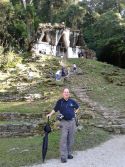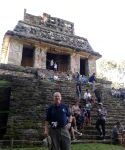January 3, 2020
We’re only 58 miles (as the crow flies) and 6200 feet lower than we were yesterday, but getting from the colonial charm of San Cristobal and its nearby Mayan descendants to the classical Maya ruins at Palenque was almost a six hour trip. Part of that was the descent which followed a lot of ridgelines, which meant curved type C roads (meaning usually not wide enough to pass, at least in theory); part of the delay was from topes—speed bumps. Our driver/guide said on one trip he counted the number, and it was 259, but that needs to be updated. The speed bumps not only replace stop lights and stop signs in towns as ways to slow traffic at important junctures (school crossings for example), but enterprising shopkeepers have them built up daily to encourage traffic to stop for bananas, the omni present coke, or pollo (chicken), or gasoline or….
 Part of the length of the trip came from a short side trip to Aqua Azul, a national park (meaning three toll booths) to view cascades on the local river that is known for its blue green water during the dry season (now) and its muddy turbulence during the rainy season.
Part of the length of the trip came from a short side trip to Aqua Azul, a national park (meaning three toll booths) to view cascades on the local river that is known for its blue green water during the dry season (now) and its muddy turbulence during the rainy season.
It was worth the drive down through at least three ecosystems, starting with pine and ending with humid jungle (there are howler monkeys sharing the resort we’re at with us); Palenque has a well-deserved reputation as one of the top ruins in the Mayan period, and with reason.
While the settlement began about 100 bc, the heyday was during the reigns of King Pakal, his son, and grandson, in the 8th century (700-800 or so). Pakal was a successful warrior, and constructed buildings that were artistic monuments to his success. And he lived to be 80 years old, unheard of at the time, and was thought to possess magical powers because of a deformed leg.
 The temples/tombs/palaces, which comprise the majority of the excavated sites (a small portion of the site) mark the architectural highlights of the classic Mayan period (700-900). The buildings are mostly pyramid shaped, towering probably 150 high, at one time embracing a city of maybe 100000 people. There’s a tomb for Pakal, his official wife (the Red Queen, so named because of the cinnabar sprinkled on her), an unexcavated Jaguar temple (something like 20 temples have been excavated, or at least named; as I saw in Cambodia, left alone, the jungle always wins), and a huge palace with an underground stream forced to go through a narrow passage and thus speeded up to the point where it had enough pressure to supply the palace with running water.
The temples/tombs/palaces, which comprise the majority of the excavated sites (a small portion of the site) mark the architectural highlights of the classic Mayan period (700-900). The buildings are mostly pyramid shaped, towering probably 150 high, at one time embracing a city of maybe 100000 people. There’s a tomb for Pakal, his official wife (the Red Queen, so named because of the cinnabar sprinkled on her), an unexcavated Jaguar temple (something like 20 temples have been excavated, or at least named; as I saw in Cambodia, left alone, the jungle always wins), and a huge palace with an underground stream forced to go through a narrow passage and thus speeded up to the point where it had enough pressure to supply the palace with running water.

I was really glad that we’d gone to Mexico City last year and visited the National Archeological Museum there, because some of the choice relics are there—in particular the jade death mask of Pakal. The highlight in the museum here is a replica of the sarcophagus of Pakal, a huge box with elaborate stone bas reliefs that have some of the best-known glyphs of the period.

Our host at the resort is an Italian/German who studied Mayan linguistics and he told us that the writing was initially translated by a Russian (as part of the cold war efforts to find things useful to intelligence) while Westerners were slower to decipher the writing. The big push came in the 90s, and he estimated about 85% of the script can be read. As a result, we know much about the Mayans.
I’m struck again at the similarities between the Mesoamericans and the Cahokia mound builders. For example, the classic birdman piasa stone looks like something out of Mayan central casting, and the pyramid in Cahokia is a pale earthen copy of the Mayan ruins. I suppose what it shows is that even before the internet and air travel, there was cultural sharing in the Americas, perhaps even more than there is today.